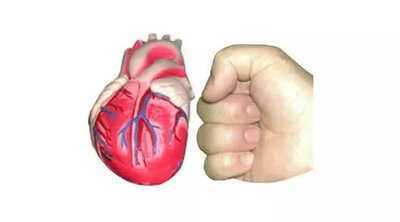Your Fist vs. Your Heart: The Surprising Connection!

The Human Heart: The Mighty Pump That Keeps You AliveThe heart is one of the most important organs in the human body. It is responsible for blood pumping, which carries oxygen and nutrients to different parts of the body. The heart continuously works like a pump, ensuring that the body functions properly.
An adult human heart weighs between 250 to 350 grams and is located in the center of the chest, slightly tilted to the left. The size of the heart can vary depending on several factors, such as age, gender, and overall health.

The Heart-Fist Size ComparisonThe idea that the heart is about the same size as a person's fist comes from anatomical observations. When looking at a human heart, its general size closely matches the size of the clenched fist of the same person. This comparison helps people visualize the approximate size of their heart without needing medical tools or imaging.
Why is This Comparison Made?
Easy to Understand: Comparing the heart to a fist is a simple way to explain the heart’s size, especially to children and those who are not familiar with medical terms.
Practicality: Since everyone can make a fist, it gives a rough estimate of heart size without requiring measurements.
Biological Consistency: Studies have shown that in most people, their heart size is close to their fist’s size when clenched. Scientific Explanation behind comparisonWhile the heart and fist are often similar in size, they are not identical. Some key scientific facts related to this comparison are:
Heart Growth and Development: The heart grows as the body grows. In newborns and children, the heart is proportionally larger compared to their body size, but as they grow, the heart’s size remains close to that of their clenched fist.
Heart Size Varies by Individual: Some people naturally have larger or smaller hearts than their fists, depending on their genetic makeup, health conditions, and body size. Athletes, for example, often have larger hearts due to the demands of intense physical activity.
Heart Shape vs. Fist Shape: The human heart is not a perfect sphere like a fist. It has a more complex structure with four chambers and major blood vessels, making its shape more elongated than a typical fist. Image:

Factors That Affect Heart SizeMajor factors that determine the actual size of a person’s heart, including:
Age: Babies have smaller hearts, but as they grow, the heart increases in size.
Gender: On average, males have slightly larger hearts than females.
Physical Activity: People who engage in regular cardiovascular exercise develop stronger and sometimes larger hearts.
Health Conditions: Some medical conditions, like heart disease or high blood pressure, can cause the heart to enlarge (a condition known as cardiomegaly). Image:

Does Everyone’s Heart Match Their Fist?While the fist-heart comparison is a useful generalization, it is not a precise measurement. Some individuals may have significantly larger or smaller hearts than their fists due to genetics or medical conditions. The heart is measured more accurately using medical imaging techniques like an echocardiogram or MRI.
The saying that the heart is the same size as the fist is a helpful and widely accepted approximation, but it is not entirely precise. This comparison is based on general anatomical observations and provides a simple way to estimate heart size. However, due to individual differences, the actual size of the heart can vary. Regardless of size, the heart remains a vital organ that plays a crucial role in keeping the body alive and functioning properly.
Understanding the heart’s size and function helps us appreciate the importance of cardiovascular health. Taking care of our heart through regular exercise, a balanced diet, and a healthy lifestyle ensures that this powerful organ continues to support us throughout our lives.

 The Human Heart: The Mighty Pump That Keeps You AliveThe heart is one of the most important organs in the human body. It is responsible for blood pumping, which carries oxygen and nutrients to different parts of the body. The heart continuously works like a pump, ensuring that the body functions properly.
The Human Heart: The Mighty Pump That Keeps You AliveThe heart is one of the most important organs in the human body. It is responsible for blood pumping, which carries oxygen and nutrients to different parts of the body. The heart continuously works like a pump, ensuring that the body functions properly.
 The Heart-Fist Size ComparisonThe idea that the heart is about the same size as a person's fist comes from anatomical observations. When looking at a human heart, its general size closely matches the size of the clenched fist of the same person. This comparison helps people visualize the approximate size of their heart without needing medical tools or imaging.
The Heart-Fist Size ComparisonThe idea that the heart is about the same size as a person's fist comes from anatomical observations. When looking at a human heart, its general size closely matches the size of the clenched fist of the same person. This comparison helps people visualize the approximate size of their heart without needing medical tools or imaging.


